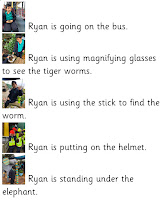Literacy for all
Describe your process for developing hypotheses (hunch) e.g. what you read, who you talked with.
I met with sally Clendon and we talked about a range of strategies I could try with the diverse nature of the students I work with.
Explain the hypotheses about teaching that you decided were MOST worth testing, and why.
“We do not believe that a different curriculum is required in order for children with disabilities to succeed in learning to read and write. We have learned, however, that teachers must attend consciously and thoughtfully to the significant learning differences of children with disabilities in order to make good instruction accessible to these students.”Karen Erickson and David Koppenhaver from Children With Disabilities: Reading and Writing the Four Blocks Way
Writing is Important
• Writing is a window into a child’s current understandings.
• Students who write become better readers, writers, and thinkers
• Some children may learn to access written communication via writing where others may learn to access spoken communication via writing.
• Writing is a form of communication
• Children with significant disabilities benefit from the SAME literacy experiences and instructional approaches used with typically developing children .
I will be investigating a range of writing tools and see what works best for my students with diverse challenges.
http://literacyforallinstruction.ca/alternative-pencils-2/
Alternative writing tools/Pencils
• For students who can not independently access traditional writing utensils, we must consider alternatives.
• Anything that provides the student with access to ALL 26 letters of the alphabet
• Pick a “pencil” (writing tool) that has the least brainpower going to form so you can focus on the function of writing. – With limited, unreliable movements, pick one that has the most potential to develop
• Students do not need to demonstrate the physical ability to use an alternative pencil in order to get one.
• Students do not need to know their letters or colors to start using an alternative pencil (even the color coded eye gaze frame!)
• Students learn about pencils and letters BY WRITING
. Early writing is a PERFECT way to work on motor skills and letter knowledge
The Role of Early Writing for Typical Developing Students
Emergent literacy learning starts early with the meaningful social interactions that occur between parents and their children. The modeling of writing and the many purposes of print and how it is formed (i.e. watch mum make shopping list, pay a bill or write a card) is embedded in their daily lives. A young child may begin exploring writing by making a mark or scribble on a page (or wall), mimicking what they have seen. Parents quite naturally celebrate the writing their children produce. In the process, children develop understandings about print and begin developing the required motor skills. With time and opportunity, a child's' developing understandings become increasingly sophisticated and create the foundation for conventional writing. As a child’s writing moves into the conventional, letters and spellings appear that others can recognize, read and further celebrate.
The Difficulties of Writing for Students with Significant Disabilities

